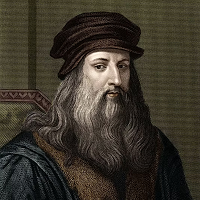

Quotes By Leonardo da Vinci

Polymath
Leonardo da Vinci
Apr 15, 1452 - May 02, 1519
Two weaknesses leaning together create a strength. Therefore the half of the world leaning against the other half becomes firm.
Shun those studies in which the work that results dies with the worker.
No man has a capacity for virtue who sacrifices honour for gain. Fortune is powerless to help one who does not exert himself. That man becomes happy who follows Christ.
There is no perfect gift without great suffering. Our triumphs and our pomps pass away; gluttony and sloth and enervating luxury have banished every virtue from the world; so that as it were wandering from its course our nature is subdued by habit. Now and henceforth it is meet that you cure yourself of laziness. The Master has said that sitting on down or lying under the quilts will not bring thee to fame. He who without it has frittered life away leaves no more trace of himself upon the earth than smoke does in the air or the foam on the water.
Good literature proceeds from men of natural probity, and since one ought rather to praise the inception than the result, you should give greater praise to a man of probity unskilled in letters than to one skilled in letters but devoid of probity.
And this network of veins acts in man as in oranges, in which the peel becomes thicker and the pulp diminishes the more they become old. And if you say that as the blood becomes thicker it ceases to flow through the veins, this is not true, for the blood in the veins does not thicken because it continually dies and is renewed.
The frog retains life for some hours when the head the heart and all the intestines have been taken away. And if you prick the said cord it instantly twitches and dies.
That cause which moves the water through its springs against the natural course of its gravity is like that which moves the humours in all the shapes of animated bodies.
Then you shall make a discourse on the hands of each animal in order to show how they vary, as in the bear in which the ligaments ofthe tendons of the toes of the foot are connected over the neck of the foot.
Describe the tongue of the woodpecker and the jaw of the crocodile.
To compare the bone structure of the horse with that of the man you should show the man on tiptoe in representing the legs.
The frog instantly dies when the spinal cord is pierced; and previous to this it lived without head without heart or any bowels or intestines orskin; and here therefore it would seem lies the foundation of move- ment and life.
If you look at a luminous body in the far distance through a smallhole it will seem to grow less, and if you look at it near at hand it will not undergo any change. That is that if you look at this light atadistance of one or two braccia from the aforesaid hole it will not undergo any change whether you are looking at it through this hole or outside of it.
The eye which finds itself in the centre between the shadows and the lights that surround the shaded bodies, will see in these bodies thegreater shadows that are in them meeting themselves within equal angles that is of the visual incidence.
Every body that moves rapidly seems to colour its path with the impression of its hue. The truth of this proposition is seen from experi-ence; thus when the lightning moves among dark clouds the speedofits sinuous flight makes its whole course resemble a luminous snake.So in like manner if you wave a lighted brand its whole course will seem a ring of flame. This is because the organ of perception acts more rapidly than the judgment.
The reason of this is that if you look at the movement of the wateryour eye will not be able to fix on anything, but its action is as that of things seen in your shadow when you are walking; for if the eyeat-tempt to distinguish the nature of the shadow, the wisps of strawor other things contained in it appear of rapid movement and it seems that these are much more swift to flee from the said shadow than the shadow is to proceed.
The sun has substance, shape, movement, radiance, heat and generative power; and these qualities all emanate from itself without its diminution.
The beginning of the branch will always have the central line of its thickness taking its direction by the central line of the plant.
The thickness of a branch is never diminished in the space there is between one leaf and another except by as much as the thickness of the eye that is above the leaf, and this thickness is lacking in the branch up to the next leaf.
This ramification of the elm has the largest branch in front, and its smallest are the first and the penultimate when the chief branch is straight.
Popular Authors









